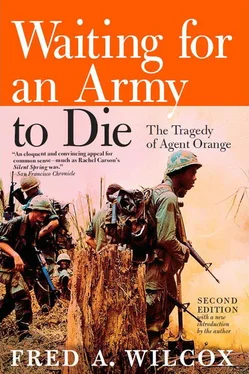But not all scientists would agree with McNulty’s conclusions regarding the mutagenicity of TCDD. In their paper “The Mutagenicity of Dioxin and Its Effects on Reproduction among Exposed War Veterans,” Vietnamese doctors Ton That Tung, Ton Duc Lang, and Do Duc Van suggest that scientists should at least consider the possibility that TCDD might act as a human mutagen. Comparing birth defects among children born to North Vietnamese soldiers who had served in the South to those among children of soldiers who remained in the North, and noting that “none of the wives of exposed or non-exposed veterans received any exposure themselves,” the doctors wrote:
The congenital malformations are of many types, with an increased frequency of anencephaly in the children of former soldiers… In spite of the limitations of the available data, it is striking to compare the absence of anencephaly among the births in the unexposed civilian population to the seven cases among the births to former soldiers. The excessive incidence of congenital malformations in the children of soldiers exposed to dioxin were discovered by interviewing each couple. In relation to national and international norms, the incidence of neural tube malformations is particularly elevated.
Likewise, the rate of abortion, premature births, and sterility is significantly higher in the group of exposed veterans from the South. Moreover, the number of molar pregnancies [18] A molar pregnancy is one characterized by the presence of a uterine mole, a fleshy mass formed in the uterus by the degeneration or abortive development of an ovum.
in Hanoi seems abnormally high; the Institute for Mothers and Children (The National Ob-Gyn Institute) has just reported the hospitalization of nineteen cases of molar pregnancies or chorioepitheliomas, of which nine were diagnosed in woman married to former soldiers from the South.
A plausible explanation for the association established between exposure to dioxin and excessive congenital malformations in first-generation offspring is that exposure may affect the father’s genetic material. This association calls for a vigorous epidemiological study taking into account the various factors which could interfere with reproduction. It also indicates that a cytologic and biological study of sperm of both man and animal exposed to dioxin should be carried out.”
A scientific paper by David Kriebel, published by the Center for the Biology of Natural Systems, Washington University, also gives a number of reasons for considering the possibility that TCDD might act as a human mutagen.
RATS ARE NOT PEOPLE: WHAT DOES ALL THIS MEAN FOR US?
Two points must be made about the significance of the experimental animal data to human health. First, bacteria, rats and people have very few things in common. But one of those few is a genetic code made of deoxyribonucleic acid (DNA). If TCDD can damage DNA in salmonella, and lacking evidence to the contrary, we must assume it can damage it in humans as well. Second, chemicals known to harm humans (benzene, vinyl chloride, cigarette smoke, to name a few) via mutational damage almost invariably do it to other organisms as well. With only one exception (arsenic) all the known human carcinogens cause cancer in laboratory animals as well.
TCDD—A HUMAN MUTAGEN
Scattered evidence supports what experimental studies suggest—that TCDD is probably a human mutagen. There is often conflicting data, and room for different interpretations; however, there is much more evidence now that there was two years ago, and this trend will probably continue. Chromosome damage has been reported in Hungarian workers exposed to TCDD in a chemical plant, and in Vietnamese civilians sprayed with the herbicide Agent Orange, which contained TCDD in small amounts (parts per million).
BIRTH DEFECTS FROM AGENT ORANGE?
Could the exposure of veterans to Agent Orange in Vietnam over ten years ago cause birth defects in their children born today? There is no direct proof, but a mechanism capable of causing this effect certainly exists. If TCDD is a human mutagen, and if it causes mutations in male germ cells, then children born of men exposed at any time in their life could develop abnormally. At least three other environmental pollutants have been shown to cause birth defects or other reproductive problems; most likely via mutations in male germ cells. 4
Neither Dr. Tung and his associates nor Kriebel argue that there is indisputable proof that TCDD is a human mutagen, but both papers suggest that the possible mutagenicity of TCDD should be examined further. Dr. Steven D. Stellman, assistant vice president for epidemiology, American Cancer Society, has also suggested that scientists continue research into the mutagenicity of TCDD. Testifying before the Subcommittee on Medical Facilities and Benefits of the Veterans’ Affairs Committee, Stellman said that it is conceivable, though not provable at this time, that Vietnam veterans exposed to Agent Orange may have increased the odds of their children would be born with defects. Stellman and his wife had been coding and analyzing some of the thousands of questionnaires sent out to Vietnam veterans by Citizen Soldier, a veterans’ organization headquartered in New York. Although, they found some of the exposure histories to be “unreliable,” Stellman felt that “the next best thing to an exposure history may be an exposure marker. [19] The most readily observable symptom or marker of dioxin exposure is chloracne.
Since we asked about skin effects in four different ways, we compared the association of one particular heath outcome—namely, the presence of any birth defect in a child born after the father’s return from Vietnam—with the presence or absence of this exposure marker. Odds ratios ranged from 1.3 to 1.8… Continuing this line of inquiry, we also found a quantitative association between the number of gastrointestinal complaints reported, and the likelihood of fathering a child with a birth defect. Taken literally, this could mean that men having the stated skin conditions were 30 to 80 percent more likely to father children with birth defects. However, without more objective clinical evaluation of the men and their children, I would caution a more conservative interpretation, and simply state that the results are highly suggestive of a possible effect, and that they should be confirmed by new studies in which the subjects are selected on a random basis rather than on their own initiative.” 5
“The problem,” Dr. McNulty explains, “is that there are enormous differences in the reactions of species to TCDD. The hamster, for example, will take a dose five thousand times as large as a guinea pig, and the hamster excretes TCDD quite rapidly. Other animals will store TCDD in their fat tissues, but the problem with doing a half-life study of this stored dioxin is that you’ve got to give just enough TCDD that you won’t kill or seriously damage the animal. And there are various estimates of what it costs to measure the dioxin in one piece of tissue, and most of them run to the order of two to five thousand dollars per sample. So we’re talking dollars again like we were with the monkeys. When people ask why these things haven’t been done, why they haven’t been measured, the answer, at least one of the basic answers, is money. ”
Dr. McNulty apologizes for a persistent cough, pauses while I examine my notes, and appears not to notice as a woman enters the office rather brusquely, lays a manila folder on his desk, and leaves. But when I ask whether the primate center has done any research into the carcinogenicity of TCDD in rhesus monkeys, he replies with the convivial irritation one might expect from a congressman asked once too often about his voting record.
Читать дальше











